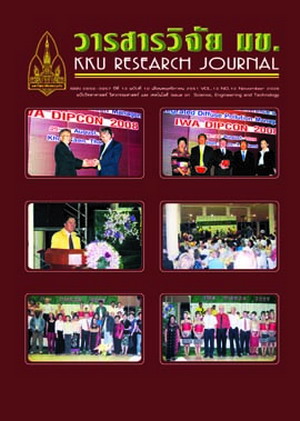Feasibility of low cost post-treatment options for the anaerobic processes of tapioca starch wastewater: Fungal Down-flow Hanging Sponge (DHS) and Bacterial DHS systems
Main Article Content
Abstract
Aim of this research is to study the performances of Down-flow Hanging Sponge (DHS) systems using mixed fungal culture and mixed bacterial culture for treatment of UASB effluent of tapioca starch wastewater. This study attemped compare the performance of the fungal and bacterial systems by systematically studying biokinetic coefficients by respirometry. Also, the influencing of sludge compositions to their microbial activity and effluent organic matter were evaluated. The remaining total BOD5 (TBOD5 ) in the effluents were about 85% removed in bacterial DHS and fungal DHS units and about 80% removed in term of soluble BOD5 (SBOD5 ). Organic loading rate (OLR) during the DHS system experiments were in range of 2.1-5.6 kgCOD/m3 -d, at 7 h HRT. Values of biokinetic coefficients showed that substrate utilization rate and maximum specific growth rate were higher for the fungal sludge in the first segment which explained the higher organic removal rate for this culture. In steady state, the concentration of retained sludge in fungal DHS remained almost constant suggesting that the degradation of old biomass nearly balance the accumulation of the fresh one. However, macromolecular compounds such as protein and carbohydrate can comprise a significant portion of organic contents in the DHS effluents.
Article Details
How to Cite
Racho, P., Wichitsathian, B., & Jindal, R. (2017). Feasibility of low cost post-treatment options for the anaerobic processes of tapioca starch wastewater: Fungal Down-flow Hanging Sponge (DHS) and Bacterial DHS systems. Asia-Pacific Journal of Science and Technology, 13(10), 1172–1184. retrieved from https://so01.tci-thaijo.org/index.php/APST/article/view/83507
Section
Research Articles


